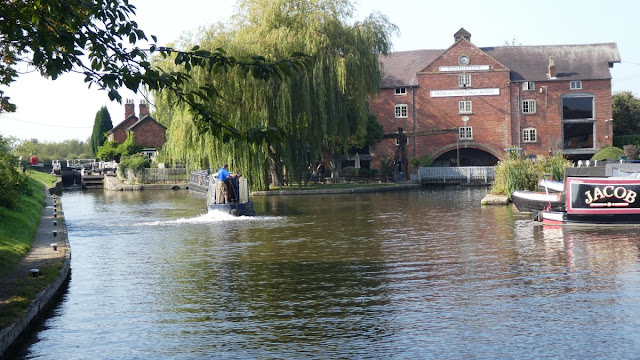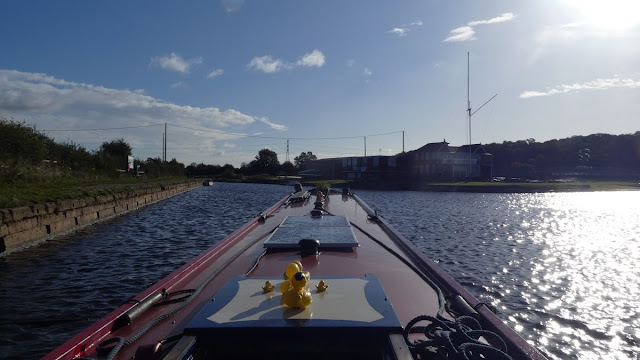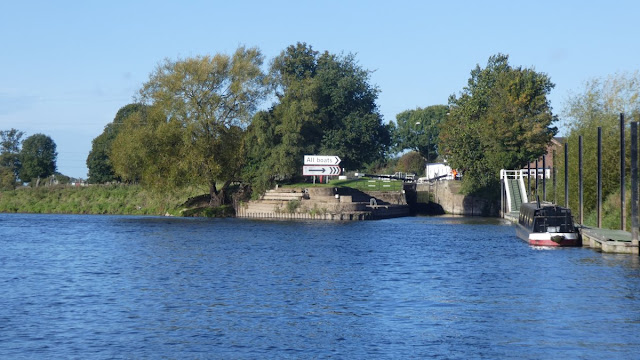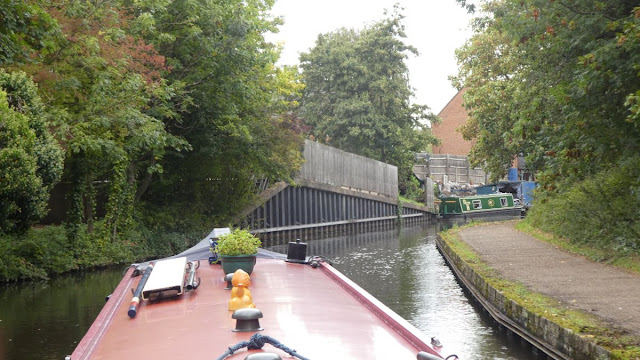We are now back home in Yorkshire, having left Leo near Nottingham for the winter. It seems a shame as the sun is shining today, but Ian has a hospital visit later this week and so we are both Covid self isolating at the moment. So here is what will probably be the last posting for this boating season taking us from Barton Turn to Nottingham.
Soon after we set off on Sunday (20th September) we came under this turnover bridge. There is no towpath under the bridge because it changes sides of the canal here. There is a saying about passing elephants or camels through the eye of a needle and here we are having a go with a narrow boat through a narrrow bridge - just inches to spare on either side. No broadbeam boats here, though beyond Burton upon Trent (specifically beyond Dallow Lock which is the last narrow one) the canal becomes wide enough to take 14 foot wide boats.This is us approaching Tatenhill Lock, one of our favourites. The lock is fairly remote with just the attractive lock house (now a B&B) beside it. Only 3 feet 7 inches fall, so an easy and quick lock to navigate with another of the very narrow bridges below it.
Apart from the noisy and tedious straights right alongside the busy A38 the passage through Burton is residential but pleasant. Having done the engine service a few days before, Ian took the cans of waste oil to the tip here. Over the years we've marked on our Nicholson's Guides the location of recycling tips that take oil and are within easy walking distance of the canals. As for the picture taken in the residential part of Burton, we liked the displays here done by a boat signwriter who presumably lives in the house and uses the end of his garden to advertise his work.
Here is Leo in Dallow Lock, the last narrow lock for this year. We had been on narrow locks for more than a week since we left Braunston and they are a delight. Dallow is even smaller than Tatenhill with a fall of only 3 feet 6 inches.
Just below Dallow at Horninglow Basin we stopped briefly to empty the toilet and then carried on.
As we approached Swarkstone Lock we passed the start of the old Derby Canal where the first hundred yards or so are still in water and are used for moorings. The Trent and Mersey continues to the right
We moored just below Swarkstone Lock and in the afternoon we got the Brompton bicycles out and cycled mostly along the disused Derby Canal into Derby. This view was taken from the first bridge looking towards the junction with the Trent and Mersey and shows the moored boats.
And this was taken from the cycleway just beyond the bridge and shows the disused canal and, beyond the bridge, is the portion in water.
 Here, we are looking the other way from the bridge. Our impression was that it would not take a great deal of work to connect Derby once again with the national network of canals. There are indeed such plans, but no proposed dates for when Leo can get to Derby.
Here, we are looking the other way from the bridge. Our impression was that it would not take a great deal of work to connect Derby once again with the national network of canals. There are indeed such plans, but no proposed dates for when Leo can get to Derby.And here is a canal bridge which used to span the Derby Canal which is now a cycleway. We were really impressed with the provision for cycles in Derby and of the 13 miles we cycled, nearly all of it was on cycleways and bridleways.
After navigating an explosion of children coming out of school, we reached the River Derwent shown here. The Derby Canal used to cross the river on an aqueduct and then went on to Sandiacre where it joined the Erewash Canal. Along the Derwent was another splendid surfaced cycle path which we followed downstream for a few miles before heading back along a bridleway.
This is Elvaston Castle which came as quite a revelation to us. Coming to a junction of bridleways we saw a sign to the castle and country park so decided to go and take a look. It is owned and maintained by Derbyshire County Council and is entirely free to enter, though the house is not open to the public.
The estate is large and we only visited a small part but we were impressed by the gardens. This is the parterre in front of the house. We wheeled our bikes through here and then followed a long straight drive to meet a road. We came back mainly by road through Chellaston. We wanted to get back onto our outward cycleway in order to get under the busy A50 and had some difficulty because new houses had been built over the bridleway but we managed in the end. We both agreed that it had been an unexpectedly delightful ride in the sunshine.
On Tuesday we went just a short way and moored above Shardlow Lock shown in the picture. Ian set to draining the gearbox oil while it was still hot. Once the job was done and gearbox refilled with new oil we had lunch and spent a pleasant afternoon walking around Shardlow and across fields to Great Wilne. At one time Shardlow was a big inland port and many warehouses and wharfs remain together with some fine houses presumably occupied then by the owners of the trading companies based here.
This the famous Clock Warehouse which is now a pub and restaurant. Boats used to go inside through the arch to load and unload.
The River Trent does a big bend here and close by Shardlow Lock you can see the river. Tomorrow we would be out on the Trent in Leo.
While we were moored an old working boat, Darley, came past and went down the lock to turn, later returning to moor behind us.
On Wednesday we had a visit from our friends Rowan and Martin together with their 3 year old grand daughter, Freya. The day started out OK with only a little light rain as we came through Shardlow and out through Derwent Mouth Lock onto the River Trent. Through Sawley Locks the rain began and once we left Sawley it came down in torrents for the last half mile to Trent Junction where fortunately there was a space on the mooring pontoon outside the Trent Lock pub. The picture shows Leo moored on the pontoon with Ratcliffe on Soar Power Station in the background. We had planned to eat out in the pub garden for lunch but, with the rain, we had a salad lunch onboard instead.
While the grown ups were chatting over lunch, Freya drew this picture of Leo (with a little help from Grandma). The orange object in the middle of the boat is our china lion teapot which lives on the roof and at the stern you can see our plastic ducks. On the stern you can see Martin and Ian wearing his boating hat. Thank you Freya; we've put the picture up on the wall inside Leo. In the afternoon Martin and Ian cycled back to Shardlow to pick up their car and we moved our car (which had been staying at their house near Derby) back to Trent Lock.
Trent Junction, like Braunston, remains an important cross roads on the canal system. North lies the Erewash Canal which runs through Long Eaton to Sandiacre and Langley Mill on the edge of the Derbyshire hills. West (the way we had come from) leads to the Trent and Mersey Canal towards Stoke on Trent, Runcorn and Manchester. East (the way we were going) takes you to Nottingham and ultimately out to the North Sea via the Humber. And south leads onto the River Soar towards Leicester and back to where we had started this year's boating. The sign in the photo faces boaters coming out of the Erewash Canal. The 'no entry' is Thrumpton Weir.
At the end of the short Cranfleet Cut is the Nottingham Yacht Club. We liked the elevated boat and the lines of painted fish at the bottom of the railings. The building is next to Cranfleet Lock.
Cranfleet Lock (seen here looking backwards) lets boats down onto the river below Thrumpton Weir.
Below Cranfleet we had nearly 4 miles of open river cruising. There are some strange objects in the water known as the Chevrons shown to the right here. We had been told by a riverman who had helped us through Cranfleet Lock that there was a dredger at work on the river below and that we should keep between the dredger and the Chevrons.
Now we had read about some shallow gravel banks in the river which had accumulated during the winter. I'm hoping you can see this one just behind us. To the right of the tiller looking back you can see an orange patch in the water. This was a gravel bank which we missed! The water is very clear and we reckon you could stand on this in water about ankle deep - certainly not enough to float a Leo. We had just seen this one and congratulated ourselves on missing it (not that we had spotted it in advance), when the boat tipped sideways and we hit another gravel bank. Ian kept the power on and fortunately we slithered off.
And just round the corner we met the dredger coming very slowly towards us. Hopefully by the time you read this the gravel banks will have been dredged to a reasonable depth.
The River Trent is a big river and quite a shock after spending the last few weeks on tiny canals. It was a fine day on Thursday so we throttled back and enjoyed the trip.
Here we are approaching Barton Island. As the sign says you go to the left of it going downstream. The island is used as a scout camp, though there was no-one there when we passed. Some of the dredgings had been dumped on the upstream end of the island.
Round another couple of bends and then Beeston Marina comes into view.
The pirate at Beeston Marina is looking both a bit laid back and a bit in need of some TLC at the moment!
Here we are approaching Beeston Lock which takes boats down off the river onto the Beeston Canal towards Nottingham. The floating buoys mark the continuation of the river which would lead over another weir.
The pilings ahead are at the junction with the now disused section of the Nottingham Canal at Lenton Chain. The Nottingham Canal used to lead to Langley Mill where it met the terminus of the Erewash Canal. From this point into Nottingham we were on the Nottingham Canal, the 'Beeston' name only referring to the short section between here and the Trent. Why 'Lenton Chain'? The answer is apparently that the Trent Navigation Company used to close their Beeston Canal from Saturday evening to Monday morning with a chain across it. Boaters were expected to observe the sabbath and many did their washing on a Sunday because, without boats moving, the water was clear and clean.
Having cycled back to Trent Lock to recover the car we were safely back on the boat when the rain started and we were treated to this fine rainbow. The odd spots on the photo are of rain. A rainbow seems a fitting end to our boating for this year. We can't see Nottingham Castle from our mooring but we can see it from the end of the marina
And finally to the statistics: this year we have cruised from 8 July to 24 September (the late start due to Covid) and we have covered 452 miles and come through 309 locks.
Our plan next year is probably to go north. We may decide to keep this blog for any momentous boating events (crossing the Channel? No, only joking) but maybe it's time to stop doing a regular account. If you have any thoughts on this then let us know by leaving a comment. Many thanks for your attention and for the kind comments.




































































